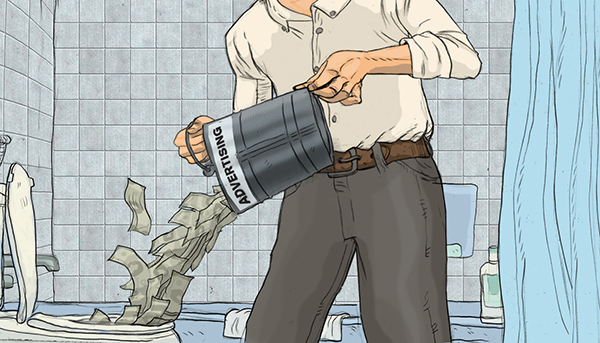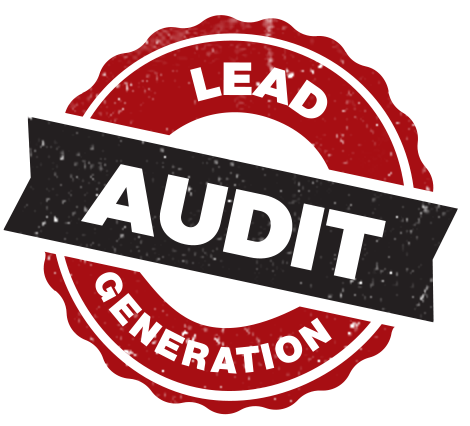Take A Few Minutes To Figure Out Your Numbers…
Then Spending Money Becomes Slightly Less Stressful.
Written by Rich Harshaw.
Give me the proverbial nickel for every time I’ve heard someone say, “This advertising costs too much!” and I could afford to buy my own Caribbean island.
Clients practically go into cardiac arrest when they find out it costs $32,000 a month to run six spots a week on the six o’clock news. It is pretty easy to get sticker shock when you see that a sixty-second radio commercial on a popular Los Angeles station could cost you a thousand bucks. Each. Or when you realize that a newspaper ad in your city barely bigger than a Hershey Bar will cost a couple thousand dollars. It’s easy to automatically think that’s a lot of money.
Now here’s the important question for you, the advertiser: Does the ad actually cost too much?
So what’s the answer? The savvy advertiser will tell you that the cost of the ad is not the issue. What’s important is the return that the ad will bring. If you were charged even as much as $40,000 for a sixty-second radio commercial that generated enough sales to make you a profit of $50,000, then would the $40,000 be A LOT? The answer is NO! Of course not! You’d be a fool not to beg, borrow, or steal the $40,000 so you could make the $50,000 profit! Try getting that kind of return in the stock market!
So how do you think that these big companies can afford to spend a million and a half dollars for a thirty second TV commercial during the Super Bowl? They know that an enormous amount of people will see it—enough to make the return on investment a good deal.
The point is simple; you’ve got to figure out how much money an ad—or a campaign of ads—will make you before you draw a conclusion of whether or not it costs too much. So how do you do that? It’s actually pretty easy. Here’s a simple process for determining the Return on Investment, or ROI, of an ad.
Step 1: Know Your Gross Profit: First, you’ve got to know how much profit you make on each sale. So if you buy something for $50 and sell it for $100, your gross profit is $50. Or to put it in simple remodeling terms, if a $10,000 job costs you $5,000 in materials and labor, then your gross profit is $5,000, or 50%. You probably already know this number for your business.
Step 2: Know Your Closing Ratios: Step two is to figure out what your closing ratio is. If, on average, you close one sale for every four people who inquire, that’s a 25% closing ratio. If nine out of ten end up buying, then your closing ratio would be 90%. This is simple math, and you probably have a good idea. But be honest with yourself—make sure you calculate ALL the closing ratios of even your lousy salesmen.
Step 3: Know Your Break-Even: Now, figure out what your break-even is. Do this by taking the cost of the advertisement and divide it by the amount of gross profit per sale. Remember, we already figured out what your gross profit is a second ago. So how much do the ads costs? If the ad campaign costs $10,000 and your average gross profit is $5,000, that means you’ve got to make two sales to make back the $10,000—that’s your break-even point—in this example, it’s two sales.
Step 4: Figure Out Leads Needed: Fourth and last, figure out the number of leads you need to generate from the ad if you are to break even. To do this, you’ve got to know your closing ratio, which we just figured out also. Let’s say it’s 25%, or in other words, you close one out of four people who inquire. So if you close 25%, and you need two sales to break even, that indicates that your $10,000 worth of advertising needs to generate eight home improvement leads to break even.p>
This is all pretty simple. We just calculated in the example that if the $10,000 ad campaign can generate eight leads, you would break even. That’s a return on investment of zero. Not particularly impressive, I realize… but hey, let’s START with breaking even so you know the bare minimum you can accept when running an ad. At least you didn’t come up with a NEGATIVE return on investment!
Now, what if your goal is to double your money? What would have to happen to your numbers? That’s right, you’d have to double your lead flow, or in this case, generate sixteen leads instead of just eight. That means that if you generated sixteen leads, you would generate a profit of $10,000—again, on $10,000 spent. In other words, you’ve doubled your money. Your return on investment is 100%. That’s pretty easy to follow, isn’t it? By way of review, what we’re trying to do is calculate your return on investment for your advertising.
Here are the four steps again. Think about your numbers in your business.
- What’s your gross profit per sale?
- What’s your closing ratio?
- What’s your break-even…in terms of number of sales needed?
- How many leads does your ad need to generate for enough sales to break even?
- What’s your return on investment on any given number of leads that you generate?
Now let’s take it a step further. Let’s figure out what’s known as the Lifetime Value of a Customer. What if your average customer brings you a $5,000 gross profit per sale like in the example we just went through? Is that the only time that customer will ever buy anything from you? How many times does that average customer come back in the course of a year—or five years? Are there things you could be doing to get them back that you’re currently not doing? Think about this a bit. How much would you be willing to spend in marketing cost to accrue that client?
Now, a couple of words of advice when figuring your return on investment for advertising. First, always estimate your numbers conservatively—or in other words, on the low side. Always figure on getting a lower number of leads than you’re hoping for and expecting. Always count on a lower closing ratio than you’re used to. If you calculate your numbers using conservative figures, then you’ll do fine if your results are actually lower than projections…and in the event that you do as well as you had initially hoped, you’ll just make more money than you expected.
Let me give you a real-life example to better illustrate ROI. There is a company who was promoting seminars where they would attempt to sell a service that cost $8,000. When they were starting to do advertising to promote these seminars, the question of how much budget should they spend came up. They wanted to start filling seminars within about a week after starting advertising, so they decided that radio would be the best way for them to quickly get the message out about the seminars. When asked how many sales they were planning on generating, they said because of a unique financing plan that allowed them to sell their package on a low monthly payment basis, they thought they could sell at least 100 packages in that five week time period.
Well, 100 packages is a lot, and they were told that they would have to spend at least $15,000 a week for the five-week period to get the number of leads required to sell that many packages. The client got his calculator out and did some quick math and realized that he had to spend $75,000! $15,000 a week times five weeks! That number—$75,000—sounded so huge, it caught him off guard. His idea was to spend just about five grand a week, or a total of less than $25,000. Big difference. That’s called “sticker shock.”
So I had him figure out the ROI, according to the steps previously explained. Again, first, figure out your gross profit per sale. His was about $5,000. Second, figure out the closing ratio. He thought his would be about 20%. So then, how many sales would he need to break even on a $75,000 advertising expenditure? Well, seventy-five thousand divided by $5,000 gross profit per sale is about fifteen sales. Just fifteen sales to break even. So if his closing ratio was 20%, he’d have to generate about seventy-five leads to break even. Seventy-five leads on $75,000 in radio on the right station? Easily attainable.
The last thing to do would be to figure out how many leads he’d have to get to reach his goal. His goal is 100 sales, and his closing ratio is 20%. That means he’d have to generate about 500 leads. That seemed fairly reasonable on a $75,000 budget. He’d generate a total gross profit on the deal of $500,000…and if you subtract out the $75,000 advertising cost, that’s still a healthy gross profit. His attitude toward the $75,000 changed instantly. Cash flow, of course, is always an important factor to consider… but the moral of this story, as always, is KNOW YOUR NUMBERS.
Well, do you see how that works now? Just run through your numbers and you’ll know how much money is a lot of money when it comes to advertising. Then you can write all those big, fat advertising checks with a smile on your face.
© 2014 – 2016, Rich Harshaw. All rights reserved.








